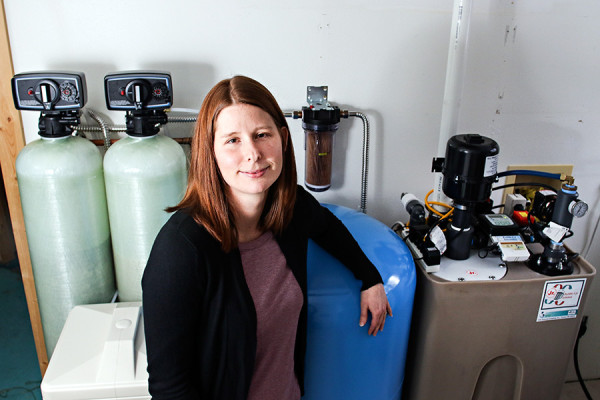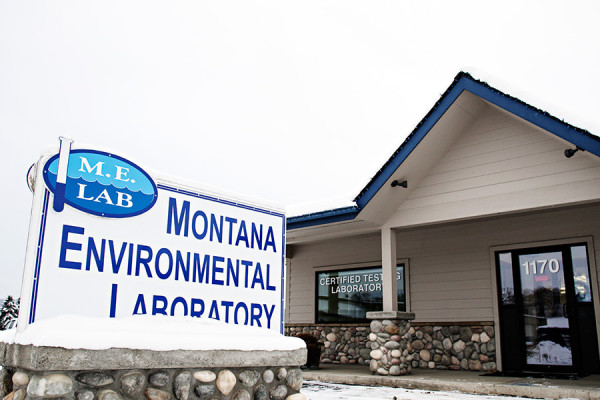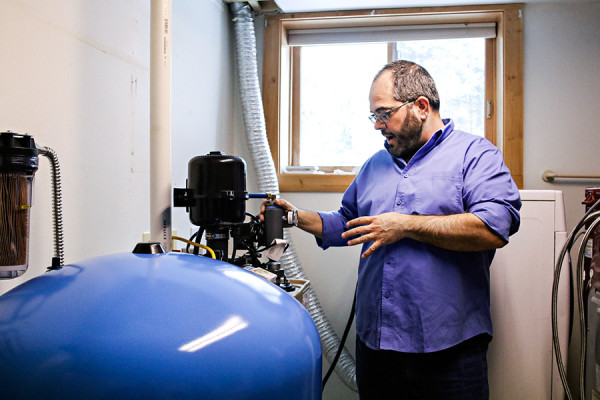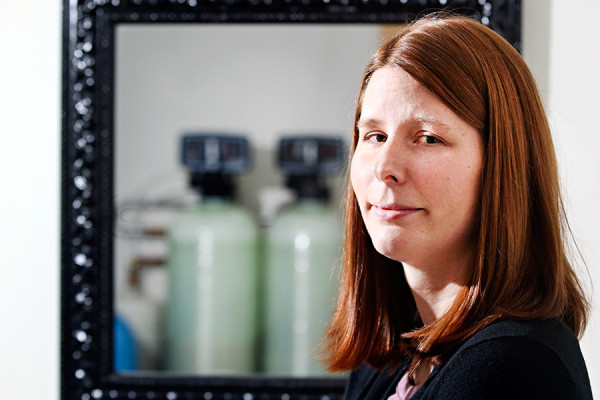The dull throbbing in Lisa Miller’s neck set in almost as soon as she and her family moved into their new log cabin home, perched in the granite hills near Kila, an unincorporated community west of Kalispell.
Her daughter felt it, too, describing the discomfort as like having marbles or rocks in her head – a cold, dizzying aura that grew more pronounced downstairs in the basement while washing laundry or running the utility sink.
“It became really clear to me that something in the environment was knocking me off my axis,” Lisa said. “I kept thinking, ‘It has to be something in the house.’”
She never imagined that her drinking water might be radioactive.
“It certainly wasn’t the first thing that came to mind,” she joked.
Lisa and her husband, Phil, tore out the old carpeting. They disinfected the entire house, scrubbed the walls and bought a top-of-the-line air purification system, but nothing helped.
When the couple discovered mold inside the panels of the basement’s drop ceiling, they hired a remediation outfit, believing it would finally solve the problem. But even after spending $4,000 on the cleanup, the throbbing pressure in the back of Lisa’s neck and head persisted.
“People thought I was crazy,” she said. “I just couldn’t understand it.”
During a visit to her chiropractor, Lisa learned that some of the private wells and public water systems in the granite-rich area west of Kalispell had historically registered high levels of naturally occurring radiological activity. Her chiropractor suggested testing the home for radon. Sure enough, an inspection revealed unsafe levels of the radioactive gas indoors, so the Millers installed a radon mitigation system.
Still, Lisa continued to experience the aching, queasy discomfort whenever she washed the laundry or ran the tap.
“I was just at my wit’s end,” she said.
At a neighborhood barbecue last July, Lisa conveyed her exasperation to a neighbor, who mentioned that the radon could be in the Millers’ drinking water, and that a number of private wells in the area contained uranium, including adjacent wells. Uranium decays to form radium, the neighbor explained, which decays to form radon.
“I left thinking, ‘Uranium? What in the world is uranium?’” Lisa recalled.
The Millers would soon learn the answer to that question, but many others were about to surface.
A month after the barbecue, the Millers received an analytical report showing that uranium, the stuff of nuclear fuel for power plants and atom bombs, was present in the family’s drinking water at a level considered unsafe by both federal and state standards. The report was ominously stamped “not potable without treatment.”
“We were about four times above the limit that the government recommends is safe,” she said.
Lisa and Phil began researching their next steps. If the couple and their five children wanted to remain in their new home, they reasoned they had to find a solution.
As they researched the health effects from long-term exposure to uranium and radon on the Internet, their concern grew exponentially.

According to the U.S. Environmental Protection Agency, a lifetime exposure to elevated levels of radioactive elements in drinking water can increase the risk of cancer and cause kidney damage. Both radon and uranium in water are generally colorless, odorless and tasteless, and radon in the air can cause lung cancer.
In particular, the radioactive elements, which occur naturally, seem to be present in the unique granitic formation flanking the communities near Kila.
“The more that we find out and the more people I meet in the neighborhood dealing with this issue, the more it makes sense. But lots of people have no clue,” Lisa said. “It just seems like there should be more information available to the public. It’s been a long, stressful journey, financially, physically and emotionally. We had no idea what was going on for the longest time.”
Federal and state water standards mandate testing for uranium in public water systems. For private well owners and small water systems like the Millers’, however, officials do not require testing for radioactivity, and are unable to point to any public health campaigns or educational outreach in affected areas, or provide residents any other help testing or dealing with uranium-contaminated wells.
Jon Cuthbertson, owner of Montana Environmental Laboratory in Kalispell, first learned about the prominence of what is called “gross alpha” radioactivity in private wells west of town more than a decade ago, when a customer asked to have her water tested for uranium. At first he was skeptical of the customer’s concerns, but he submitted the sample to humor her.
“Sometimes you get these tin-hat people, these full-moon folks who are a little paranoid and loony,” Cuthbertson said. “But sure enough, there was radioactivity in her water. A lot of it.”
The woman explained that she was dying of cancer, and hair samples tested at the hospital revealed traces of uranium, even though she had never worked near a power plant. She had, however, been drinking her untreated tap water for years, and her well contained unsafe levels of “gross alpha” activity – a measurement of the radioactive energy released as elements such as uranium break down.
The Environmental Protection Agency defines gross alpha as a form of radioactive contamination, and warns of health risks, including the potential of cancer after long-term exposure.
Since 2010, Cuthbertson has submitted 175 drinking water samples from the Kila area that tested above the maximum contaminant level for gross alpha radioactivity, according to his records. He now recommends testing for radiological elements to any customer living west of Kalispell – his lab is not equipped to test for radioactive material, so he sends the samples to a lab in Casper, Wyoming.

Cuthbertson has submitted samples from private and public water systems spanning Kila, Ashley Lake, Smith Lake, Foys Lake, Browns Meadow, and beyond – “that whole area is hot,” he said. “I really don’t know how far west it goes.”
“One of the samples was 250 times the maximum contaminant level. That’s just astounding,” he continued. “We pretty much tell everyone that’s west of Kalispell to do it. I don’t want to be a scare-monger, and it’s not like I make any money off of it, but I would want to know if there was that much radioactivity in my water.”
It’s not the first time residential areas west of Kalispell have dealt with issues related to radioactivity in the water supply.
In 2010, the state Department of Environmental Quality required 43 homes in the Lakeshore Heights Homeowners Association west of Kalispell to address concerns over radioactivity in the drinking water. The agency proposed several options, including installing reverse osmosis water systems, prompting the Lakeshore Heights Homeowners Association to launch a pilot program to determine the most cost-effective means of treatment.
At Lakeshore Heights, samples dating back to 1992 showed non-detectable gross alpha activity, according to Emily Gillespie, an environmental engineer with the DEQ in Kalispell. But over the years, possibly as more water was pumped through the wells, the levels have risen, coming out of the bedrock walls.
Federal law, as mandated under the EPA’s Safe Drinking Water Act, states that the maximum contaminant level (MCL) for gross alpha activity is 15 picocuries per liter. Lakeshore Heights was averaging over 30. According to a 2009 Environmental Working Group report, Lakeshore Heights had the highest recorded gross alpha levels of any public water system in the state.
It was the first public water system in the state to receive a mandate from DEQ to treat for gross alpha radioactivity, and it became a financial nightmare for the homeowners association.
But then the subdivision found another, cheaper way to bring the system into compliance with the EPA standards – by submitting the samples to a different lab.
“That was a long process. We considered everything and the costs were just unbelievable,” said Tina Malkuch, a resident at Lakeshore Heights, who at the time served as the association’s certified water systems operator. “Then we found this other lab that gave us results that are acceptable.”
Lakeshore Heights, as well as five other water systems exceeding the MCL for gross alpha, had been sending their samples, via Cuthbertson at Montana Environmental Laboratory, to Energy Labs in Casper, Wyoming, which performs an EPA-approved method labeled 200.8 to test for uranium, charging a cost of $25 per sample.
However, the Wisconsin State Laboratory of Hygiene, in Madison, Wisconsin, performs a different EPA-approved method labeled SM7500 U.C., charging a cost of $216 per sample.

When Lakeshore Heights and four other subdivisions submitted their samples to the Wisconsin lab, they fell within compliance of the EPA standard, and operators like Malkuch breathed a sigh of relief.
“If you were to put in one huge treatment system, which we considered doing, then the wastewater would have to go into a drain field site and that drain field site would then become hazardous waste. And when you have to replace that hazardous waste every five to 10 years, the costs were impossibly high,” Malkuch said. “That is why we went out digging to find some other solutions, and we ended up just taking the samples to a different lab. They just use a different method that gives you different results.”
Those results were presented in a 2010 Consumer Confidence Report, in which Malkuch assured residents that “Lakeshore Heights can now in fact say after a year and a half that we do not have a gross alpha problem.”
Still, some residents have taken their own steps to treat their drinking water.
Tony Dammel, who owns Culligan Water in Kalispell and lives at Lakeshore Heights, estimates he’s installed treatment systems in a dozen or more Lakeshore Heights homes, including in his own.
“All I drink is RO (reverse osmosis) treated water because I know what’s not in it,” he said. “I won’t personally drink the untreated water.”
Cuthbertson said that while he’s not a physicist, it’s peculiar that two testing methods could return such markedly disparate results on water samples from the same system.
“The EPA accepts both methods, and that is what drives me a little bit crazy,” Cuthbertson said. “We have these subdivisions using two legal methods that give you radically different numbers. They aren’t doing anything wrong. Both methods are legal. It just doesn’t seem right.”
“If I lived out at Lakeshore Heights I would have a reverse osmosis system,” Cuthbertson added. “I don’t like the idea of having that much radioactivity in my water whether it’s a legal loophole or not.”
Wes Kruse, the current systems operator at Lakeshore Heights, said he doesn’t understand the nuances that distinguish the two methods, only that both methods are acceptable by the federal government, and one method consistently returns lower results.
“I wish I could tell you why, but one method gives us a workable number,” Kruse said. “I am the operator and I do take those samples. I don’t analyze them and I don’t know the difference between the testing methods. All I know is that the EPA allows both, and by us using the lab’s method in Wisconsin we stay in compliance.”
Eugene Pizzini, the DEQ’s supervisor of public drinking water supplies, initially shared Cuthbertson’s skeptical reaction when he learned of the disparities in the testing methods, thinking that the homeowners associations were exploiting a quirk in the law.
“I thought, ‘Why would you allow a method that would allow you to underreport?’” Pizzini said. “The only reason a subdivision would choose to do that method is so that they would not be forced into installing a million-dollar treatment plant.”
In subsequent interviews with the Beacon, Pizzini changed his views “180 degrees,” and says that the Wisconsin method gives a more accurate representation of the actual uranium activity compared to the Wyoming lab.
Uranium activity consists of two isotopes – 234 and 238. But the Wyoming method tests only 238, which makes up about 99 percent of the total uranium mass that a human kidney has to process. It does not measure for 234, however, which is only responsible for 1 percent of the mass but 75 percent of the radioactivity.
Using the Wisconsin method, “the higher uranium value can be subtracted from the gross alpha value, therefore bringing the system into compliance,” explained Ben Schendel, the DEQ’s former radiological rule manager.
In 2010, Schendel helped the Wisconsin lab get certified in Montana for public water system sampling, and subdivisions from Kila to Bigfork began requesting the lab’s testing method.
Pizzini said now that he understands how the Wisconsin method works he has no qualms about it.
“The EPA would not adopt or keep a method that was allowing people to skirt the requirements,” Pizzini said. “The more expensive method is just a more accurate representation.”
Diane Jordan, the DEQ’s current radiological rule maker for Montana, said the only community water systems she knows of using the Wisconsin lab are in Northwest Montana, in part because a former board member of the Ranch County Water Board in Bigfork helped promulgate information about the alternative testing method.
“Someone in that area discovered this method and gave a presentation about how it returns lower numbers and is very much approved by the EPA,” Jordan said. “They use it because otherwise they would hit the maximum contaminant level and they would have to put up a treatment center.”
Residents like the Millers may or may not see lower numbers by testing their method using the Wisconsin method, and they hope they won’t have to.
Last month, the Millers installed a specialized water treatment system that strips the radon gas out of their water and a separate ion-exchange filter that removes the uranium. It cost $10,000, and the family hopes it’s their last major investment fixing a problem they didn’t know existed when they bought their home.

Lisa has never felt better, and the rocks and marbles are gone from her daughter’s head. But she’s still concerned about the dearth of information available to the public about radioactive contaminants in the area.
“I mean, you look at the people buying $250,000 houses out here and they have no idea,” she said. “It worries me.”
She’s not alone.
Jennifer Benjamin lives near the Millers, and had her water tested for uranium in 2002, after a hair test revealed high concentrations of the radioactive element. She tested her well, and the results showed that her drinking water contained nearly four times the MCL for uranium.
Benjamin did some research and began wondering if the tainted water supply might have something to do with her 16-month-old daughter’s anemia.
Her pediatrician said that while the results were high, it was unlikely that exposure to the water had caused any health problems in her daughter. A few months later, the girl was diagnosed with leukemia, and the family spent the next year at the Seattle Children’s Hospital while the girl underwent treatment. Benjamin was convinced it was because of their water.
“Knowing that exposure to uranium increases the risk of cancer, we’ve always thought that it had something to do with her leukemia,” Benjamin said, adding that her daughter, now 14, has been cancer-free for 10 years, and that the family installed a water treatment system.
Pennie Ulvila, the postmaster at the Kila Post Office, said she learned of the presence of uranium in the water years ago and hasn’t been drinking the water ever since.
“When I started working at the Post Office 10 years ago they said, ‘Don’t drink the water, it’s bad.’ And then we had it tested and there were unsafe levels of uranium,” Ulvila said. “To treat that was way more costly than just letting us get bottles of Culligan water. That was the first time I heard of it. I had been here 10 years and nobody had ever said anything. Now people are starting to talk about it more.”
Families like the Millers and the Benjamins are surprised there’s not more public outreach for homeowners on private water systems, but DEQ officials say the resources are not available.
“There’s just nothing we can do for them. We can’t expend public money on private wells,” Pizzini said.

Gillespie, with the Kalispell DEQ office, said it’s important to note that the federal standards are based on a lifetime of exposure to radioactive elements, and acute, short-term health effects are unlikely.
“The thing that I always want to reiterate is that the maximum contaminant level for radiological activity is set for long-term ingestion, so it is certainly not going to have an acute effect,” she said. “So people need to keep that in mind in terms of how long they want to be in their home and how long they have been in their home.”
Flathead County Public Health Officer Joe Russell said there’s no public record of testing for radioactivity in private wells in the area because resources have been reserved for public systems.
“Everything is focused on public water supplies, and anytime private wells are sampled it usually comes in the forms of grants,” he said.
Gillespie said there is information about radioactivity in drinking water on the DEQ website, and encouraged concerned members of the public to contact the agency’s Helena office, and write their lawmakers.
“We always struggle to have enough time and resources to get those kinds of words out,” Gillespie said. “I think that if that’s something that is important to residents they should contact us and contact their state legislator, because that is who decides how we spend our time.”
